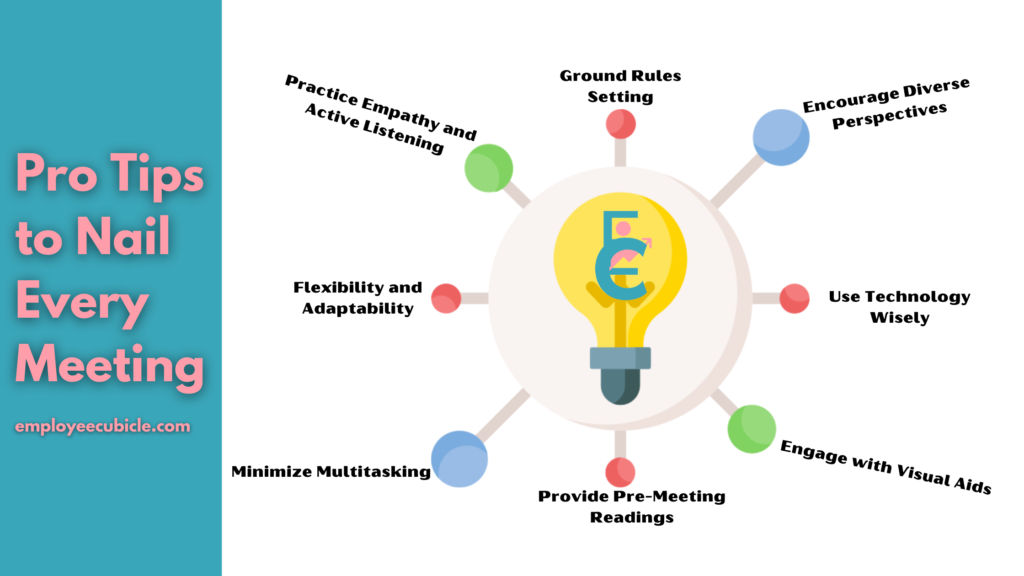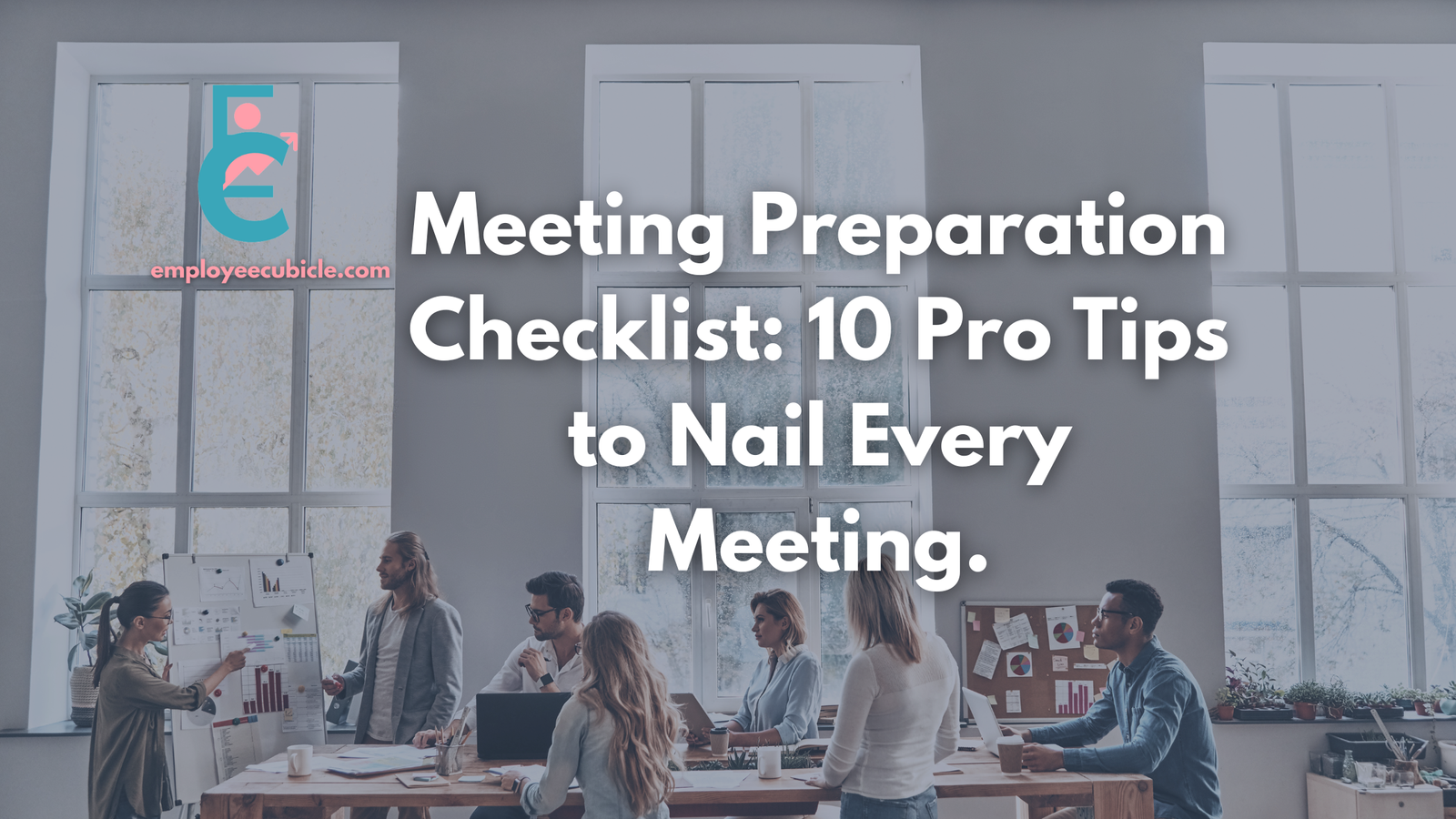Ever wondered how a Meeting Preparation Checklist might be the secret weapon to revolutionizing those office get-togethers?
Picture this: No more yawning through aimless discussions or leaving a room thinking, “What just happened?” Instead, visualize meetings that spark energy, foster collaboration, and end with everyone crystal-clear on their next steps.
Meetings are a staple in our work lives, from the fresh intern to the experienced HR manager. But not all meetings are created equal.
Dive into “Meeting Preparation Checklist: 10 Pro Tips to Nail Every Meeting” and uncover the strategies to elevate every gathering. By the time you finish this post, you’ll be brimming with insights to lead meetings that people actually look forward to. So, are you ready to be the meeting maestro everyone admires? Dive in and let’s transform those meetings together!
Why Proper Meeting Preparation Checklist Matters?
We’ve all been there – trapped in a seemingly never-ending meeting, where the clock ticks slower, and the points of discussion circle around without any clear direction. It can be tempting to assume that this is just the nature of meetings. But what if there’s a way to change this narrative? Enter the world of the Meeting Preparation Checklist, and let’s discover why gearing up appropriately for a meeting can make all the difference.

Enhanced Productivity
- Without ample preparation, meetings can quickly devolve into unproductive chatter.
- A well-prepared meeting means that every moment spent in the conference room or virtual call is geared towards achieving a clear objective.
- When you have a robust Meeting Preparation Checklist in place, it ensures that all the groundwork is done in advance, leaving the meeting time for actionable discussions.
Respect for Everyone’s Time
- Time is a precious commodity, and everyone’s day is packed with tasks.
- Going into a meeting without proper prep can feel like an unexpected detour on a busy day.
- By having a plan and sticking to it, you’re showing respect for everyone involved by valuing their time.
Clear Communication
- Have you ever left a meeting more confused than when you entered? It’s not a rare phenomenon, but it’s certainly avoidable.
- Preparing for a meeting ensures that the information is presented in a clear, concise manner, leaving little room for misunderstandings.
- A Meeting Preparation Checklist can serve as a guide, ensuring that all crucial points are covered and that the meeting flows seamlessly from one topic to the next.
Boosted Confidence
- It’s no secret that walking into a room (even a virtual one) armed with knowledge and a plan can significantly boost confidence.
- When you’re prepared, it reflects in your demeanor, tone, and the quality of your contributions.
- Knowing you have all your bases covered allows you to focus on the discussion rather than scrambling to remember key points.
Facilitates Decision Making
- One of the primary purposes of many meetings is decision-making.
- Having all the relevant information, data, and materials ready ensures that decisions can be made efficiently and effectively during the meeting itself.
- A well-executed Meeting Preparation Checklist ensures that all potential questions can be anticipated and addressed, making the decision-making process smoother.
Encourages Participation
- Meetings aren’t just for the one leading; they are collaborative spaces where every voice holds value.
- When a meeting is structured and well-prepared, it encourages everyone to participate, fostering a culture of collaboration and inclusivity.
In essence, while it might seem like an extra task to prepare meticulously for every meeting, the dividends it pays in terms of time saved, productivity gained, and relationships built are invaluable. Think of the Meeting Preparation Checklist not just as a to-do list but as a roadmap to meaningful and efficient interactions. So, the next time a meeting invites lands in your inbox, remember the power of preparation and let it guide you towards a more productive and engaging discussion.
What are the Most Important Meeting Preparation Checklist Items?
You might have heard the saying, “Fail to prepare, prepare to fail.” In the world of meetings, this couldn’t ring more true. A well-crafted Meeting Preparation Checklist doesn’t just ensure a smoother flow; it’s the backbone of truly productive discussions. Curious about the components of an effective checklist? Let’s unwrap the essentials!
- Set a Clear Objective
- Defining the ‘why’ behind the meeting is crucial. Are we brainstorming? Making a decision? Setting quarterly goals?
- This clarity acts as a beacon, guiding discussions and ensuring that the team remains on course throughout.
- Draft a Detailed Agenda
- Much like a recipe, an agenda lists out the ingredients and steps of your meeting.
- By laying out topics in a logical flow, you ensure everyone’s on the same page, reducing sidetracks and tangents.
- Identify and Invite Key Stakeholders
- Think of this as gathering the main cast for a play. The plot won’t progress if the lead characters are missing.
- An effective Meeting Preparation Checklist will help identify who brings value to the table, ensuring they’re present to share insights.
- Choose the Right Platform and Environment
- The setting can influence the mood. While some topics are best discussed face-to-face, others might thrive in a virtual space.
- Tech checks and environment preps can help avoid unwanted interruptions, making meetings more seamless.
- Allocate and Communicate Roles
- Just as a ship has its captain, navigator, and crew, meetings benefit from clear role allocations.
- When everyone knows their responsibility, they’re more engaged and contribute more effectively.
- Pre-distribute Essential Materials
- Imagine walking into a book club without reading the book. Pre-shared materials ensure everyone is on the same page (literally and figuratively).
- With a Meeting Preparation Checklist in hand, you ensure nothing vital slips through the cracks.
- Plan for Engagement
- Interactive elements can transform meetings from monologues to dialogues.
- Activities, brainstorming sessions, or quick polls can breathe life into discussions, making them more memorable and effective.
- Anticipate Potential Roadblocks
- Every plan may have its hiccups. But with foresight, these can be minimized or even avoided.
- Whether it’s potential tech glitches or challenging topics, coming prepared means you’re ready to tackle any bumps in the road.
- Allocate Time for Feedback and Wrap-up
- The closing minutes of a meeting are its cornerstone. It’s where decisions solidify, and actions take shape.
- Additionally, by opening the floor to feedback, you embrace a growth mindset, welcoming improvements for future meetings.
- Document Everything
- As we move from one task to the next, it’s easy to forget details.
- A designated note-taker or a documentation tool ensures that insights and decisions aren’t lost to time.
In essence, a Meeting Preparation Checklist isn’t just about ticking off tasks. It’s about paving the way for successful collaborations, fostering an environment where everyone feels heard and valued. As you steer through your next meeting, let this checklist be your compass, guiding you towards meaningful and impactful discussions.
What are 10 Pro Tips to Nail Every Meeting?
Meetings: they can either be the highlight of your workday or a drag that seems to stretch for eternity. But what if with just a few tweaks, every meeting could be turned into a productive, engaging experience? Using the right Meeting Preparation Checklist and embracing some pro-tips can lead the way. Let’s explore these game-changers!
- Use Technology Wisely
- No one likes the awkward “Can you hear me?” dance.
- Checking your tech tools ahead ensures a smoother virtual experience.
- In our tech-driven world, tools like interactive polls or digital whiteboards can elevate a meeting’s engagement levels.
- However, it’s essential to strike a balance. Using technology should enhance the human connection, not replace it.
- Engage with Visual Aids
- Visual stimuli can enhance comprehension and retention.
- Use slides, charts, or even quick sketches to illustrate points and maintain engagement.
- Icebreakers and Energizers
- Beginning with a collective sigh of shared experiences or a quick, fun trivia question can set a positive tone. Icebreakers not only lighten the atmosphere but can also facilitate team bonding.
- Especially useful for teams that don’t interact daily, these short activities can bridge the gap, foster camaraderie, and get those creative juices flowing.
- Mindful Timing
- Not all hours are created equal. A 3 PM meeting post-lunch might see participants struggling to stay alert, while a 10 AM gathering might harness peak productivity.
- Scheduling meetings keeping in mind the general energy ebbs and flows can optimize attention and participation.
- Limit Meeting Length
- Ever found yourself glancing at the clock during an endless meeting? Keeping sessions crisp ensures everyone stays on track and remains engaged.
- Employ techniques like the Pomodoro method – short bursts of intensive discussion followed by a brief break – to maintain enthusiasm.
- Encourage Diverse Perspectives
- A room echoing with agreement might be peaceful, but it’s not where innovation happens. Encouraging a diversity of thought can lead to breakthrough ideas.
- Inviting individuals from different departments or backgrounds can infuse fresh perspectives, paving the way for richer outcomes.
- Minimize Multitasking
- While taking notes on a laptop, it’s tempting to sneak a peek at emails. However, multitasking can split attention and reduce the meeting’s effectiveness.
- A proactive reminder at the start, perhaps integrated into the Meeting Preparation Checklist, can encourage attendees to stay present.
- Flexibility and Adaptability
- As important as a structured agenda is, there’s also merit in being adaptable. Some discussions might organically lead to crucial insights not originally on the agenda.
- Staying rigid can stifle creativity, while a bit of flexibility can capture spontaneous moments of brilliance.
- Practice Empathy and Active Listening
- Meetings are as much about listening as they are about speaking. Acknowledging contributions, asking follow-up questions, or even simple gestures like nodding can make all the difference.
- Ensuring every voice is heard and valued fosters a culture of mutual respect and collaboration.
- Ground Rules Setting
- Just as every game has its rules, meetings benefit from some basic guidelines.
- These can range from “One person speaks at a time” to “All phones on silent.” Ground rules ensure meetings are respectful and free from unnecessary interruptions.
- Bonus TIp:Provide Pre-Meeting Readings
- Ever felt lost in a meeting because you lacked background knowledge? Pre-meeting materials can be a game-changer.
- Sending out articles, reports, or data sets ahead of time ensures participants come in informed, ready for a deeper discussion.

Conclusion
In the bustling world of professional interactions, mastering the art of effective meetings is pivotal. At the heart of each productive gathering lies a well-thought-out Meeting Preparation Checklist. As we’ve journeyed through, it’s evident that it’s not just about ticking boxes but ensuring every interaction is meaningful, every voice is heard, and every minute counts. From setting clear objectives to celebrating small victories, each tip contributes to turning ordinary meetings into extraordinary collaborations. After all, when preparation meets opportunity, success is inevitable.
Eager to take your meetings to the next level? Start implementing these tips today! And if you’ve got a game-changing meeting tip of your own, share it with us in the comments below. Let’s learn and grow together!



